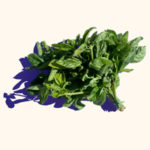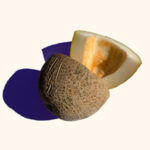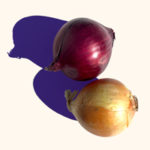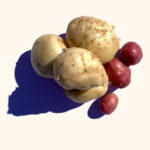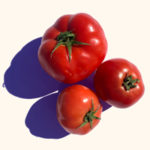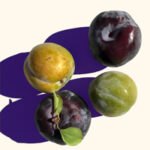What’s in my box this week?
Click on your delivery date to see what is in your box this week. Note that the web site is updated daily to reflect the NEXT day’s deliveries but before that, will show the information from the previous week. You can check an earlier day in the week to get an idea of what will be in your box, but the contents of your box may be different as the box contents frequently change between days.
Tuesday: July 29
- basil
- corn
- melon
- onions
- potatoes
- peppers
- tomatoes
*Click on produce above for Recipes
Flower of the Week: sunflowers
To keep your flowers at their best, keep the flowers out of direct sunlight, and preferably in a cooler area of your house. Change the water regularly; we recommend every other day.
DO NOT take flowers unless they are listed next to your name on the list.
Veggie Tips
Wednesday: July 30
- basil
- corn
- melon
- onions
- potatoes
- peppers
- tomatoes
*Click on produce above for Recipes
Flower of the Week: sunflowers
To keep your flowers at their best, keep the flowers out of direct sunlight, and preferably in a cooler area of your house. Change the water regularly; we recommend every other day.
DO NOT take flowers unless they are listed next to your name on the list.
Veggie Tips
Thursday: July 31
- basil
- corn
- melon
- onions
- potatoes
- peppers
- tomatoes
*Click on produce above for Recipes
Flower of the Week: sunflowers
To keep your flowers at their best, keep the flowers out of direct sunlight, and preferably in a cooler area of your house. Change the water regularly; we recommend every other day.
DO NOT take flowers unless they are listed next to your name on the list.
Veggie Tips
Tuesday: July 22
- eggplant
- melon
- onions
- plums
- summer squash
- tomatoes
*Click on produce above for Recipes
Flower of the Week: globe amaranth (gomphrena)
To keep your flowers at their best, keep the flowers out of direct sunlight, and preferably in a cooler area of your house. Change the water regularly; we recommend every other day.
This is a great flower for drying! For the best results, hang your gomphrena upside-down in a cool, dry place with good airflow. Keep it away from direct sunlight, which will fade the bright colors.
DO NOT take flowers unless they are listed next to your name on the list.
Veggie Tips
Eggplant – We grow a few different types and you can view them on our website, in addition to many excellent recipe ideas. The different shaped eggplants can have slight textural differences but can all be used interchangeably, just pay attention to the way you’re cutting them and keep these cooking tips in mind. While you’ll see suggestions not to refrigerate them we do recommend that you refrigerate (in a warmer section of your fridge, if possible – follow this guidance) in a bag to prevent them from getting squishy. Though if they do get a little soft or get some cold damage, they are still very salvageable, especially if you’re making baingan bharta or baba ghanoush. Eggplant is excellent roasted; try the Recipe of the Week or this salad, described as “The Sheet-Pan Salad That Made Me Stop Hating Eggplant, Finally”). It can also be grilled (add to sandwiches, salads, or pasta like this one with zucchini or this one with plums), charred, in stir-fries (including with tomato), and in curries. They can also be steamed. This page has a rundown of several eggplant cooking methods and here’s a list with lots of tasty ideas. Additional eggplant ideas here – what are some of your favorites?
Melon – A staple of a summer Full Belly CSA box is a melon! Use the melon page on our website to ID your melon, or you can always ask us – though we’ll need a picture of the inside and outside. Melons can be stored on the counter, or in a cool spot, for a short period of time (a day or two) but we harvest them ripe so we recommend keeping them in the refrigerator for best results and bringing them up to room temperature just before eating. Once cut, all melons should be stored in the refrigerator for up to three days either cut up in a container or left whole and wrapped with plastic wrap or an eco-friendly alternative. Tip: consider sprinkling a small amount of salt on your melon, especially if it needs a flavor boost. Cubed melon can also be used in smoothies (fresh or frozen).
Onions – Finding some black spots on your onions? That’s aspergillus, a harmless fungus that can develop on harvested onions. They are perfectly safe to eat, just wash off the black soot before using.
Plums – You’re getting Santa Rosa plums this week! They have a sweet interior and slightly tart skin and are semi-firm when ripe. Once they’ve reached your desired level of ripeness, they should be stored in the refrigerator. Otherwise, they can be stored on the counter. They are great eaten as-is, but you can also add to salads (panzanella, or with tomatoes, summer squash), or cut up and added to yogurt or oatmeal. Or cook them: make a quick sauce or compote, or bake a galette, tart, bread, torte, cake, crumble, or crisp. Note: we can take the plastic baskets back.
Summer Squash – Squash should be stored in the fridge (ideally in the crisper drawer), and in a bag. The key is moisture management; you want to make sure that they don’t dry out, but they will spoil if there is too much condensation. You may want to move your squash to a plastic bag, but make sure one end of the bag is open for air circulation. Don’t wash your squash until you’re ready to use them. And when you are, we’ve got lots of ideas on our website and this website has a few more. For a different kind of pasta recipe, make pasta with zucchini sauce. Consider combining with your eggplant in a stew or a fancier tian.
Tomatoes – It’s tomato time! You’re getting mostly heirloom tomatoes. Tomatoes are best stored on the counter at room temperature, stem side down. The best temperature for storing tomatoes is 55 degrees, much warmer than the standard refrigerator. As a result, we only recommend moving your tomatoes to the fridge if they are really ripe and you’re worried about them going bad. And of course, always refrigerate cut tomatoes. See the Recipe of the Week and we have several recipe ideas on our website, and if you’ve got a recipe to recommend and share, let us know! Bulk boxes of heirloom, Early Girl, red slicer, and roma tomatoes are available to order now in the CSA Member Store, as are three pint baskets of cherry tomatoes. Note: we can’t reuse the cardboard boats, please do not leave them at your CSA site.
Wednesday: July 23
- apriums
- eggplant
- melon
- onions
- summer squash
- tomatoes
*Click on produce above for Recipes
Flower of the Week: globe amaranth (gomphrena)
To keep your flowers at their best, keep the flowers out of direct sunlight, and preferably in a cooler area of your house. Change the water regularly; we recommend every other day.
This is a great flower for drying! For the best results, hang your gomphrena upside-down in a cool, dry place with good airflow. Keep it away from direct sunlight, which will fade the bright colors.
DO NOT take flowers unless they are listed next to your name on the list.
Veggie Tips
Apriums – Apriums are a plum-apricot hybrid, about 75% apricot/25% plum and taste very similar to apricots, with a slightly firmer texture due to the plum genetics (though none of the plum tartness. Fun fact: pluots have the opposite ratio – more about these hybrid fruit here and here. They’re firmer than apricots and you shouldn’t wait until they’re super soft to eat them. But if you’d like them a little softer, we recommend letting them ripen on the counter – put them stem-side down on a plate, not in the sun. We love eating them plain, but you can add to baked goods (savory too) or desserts (add streusel, make zucchini bread), or salads (ideas: with tomato or zucchini) or take advantage of their firmness and try grilling them!
Eggplant – We grow a few different types and you can view them on our website, in addition to many excellent recipe ideas. The different shaped eggplants can have slight textural differences but can all be used interchangeably, just pay attention to the way you’re cutting them and keep these cooking tips in mind. While you’ll see suggestions not to refrigerate them we do recommend that you refrigerate (in a warmer section of your fridge, if possible – follow this guidance) in a bag to prevent them from getting squishy. Though if they do get a little soft or get some cold damage, they are still very salvageable, especially if you’re making baingan bharta or baba ghanoush. Eggplant is excellent roasted; try the Recipe of the Week or this salad, described as “The Sheet-Pan Salad That Made Me Stop Hating Eggplant, Finally”). It can also be grilled (add to sandwiches, salads, or pasta like this one with zucchini), charred, in stir-fries (including with tomato), and in curries. They can also be steamed. This page has a rundown of several eggplant cooking methods and here’s a list with lots of tasty ideas. Additional eggplant ideas here – what are some of your favorites?
Melon – A staple of a summer Full Belly CSA box is a melon! Use the melon page on our website to ID your melon, or you can always ask us – though we’ll need a picture of the inside and outside. Melons can be stored on the counter, or in a cool spot, for a short period of time (a day or two) but we harvest them ripe so we recommend keeping them in the refrigerator for best results and bringing them up to room temperature just before eating. Once cut, all melons should be stored in the refrigerator for up to three days either cut up in a container or left whole and wrapped with plastic wrap or an eco-friendly alternative. Tip: consider sprinkling a small amount of salt on your melon, especially if it needs a flavor boost. Cubed melon can also be used in smoothies (fresh or frozen).
Onions – Finding some black spots on your onions? That’s aspergillus, a harmless fungus that can develop on harvested onions. They are perfectly safe to eat, just wash off the black soot before using.
Summer Squash – Squash should be stored in the fridge (ideally in the crisper drawer), and in a bag. The key is moisture management; you want to make sure that they don’t dry out, but they will spoil if there is too much condensation. You may want to move your squash to a plastic bag, but make sure one end of the bag is open for air circulation. Don’t wash your squash until you’re ready to use them. And when you are, we’ve got lots of ideas on our website and this website has a few more. For a different kind of pasta recipe, make pasta with zucchini sauce. Consider combining with your eggplant in a stew or a fancier tian.
Tomatoes – It’s tomato time! You’re getting mostly heirloom tomatoes. Tomatoes are best stored on the counter at room temperature, stem side down. The best temperature for storing tomatoes is 55 degrees, much warmer than the standard refrigerator. As a result, we only recommend moving your tomatoes to the fridge if they are really ripe and you’re worried about them going bad. And of course, always refrigerate cut tomatoes. See the Recipe of the Week and we have several recipe ideas on our website, and if you’ve got a recipe to recommend and share, let us know! Bulk boxes of heirloom, Early Girl, red slicer, and roma tomatoes are available to order now in the CSA Member Store, as are three pint baskets of cherry tomatoes. Note: we can’t reuse the cardboard boats, please do not leave them at your CSA site.
Thursday: July 24
- eggplant
- melon
- onions
- plums
- summer squash
- tomatoes
*Click on produce above for Recipes
Flower of the Week: globe amaranth (gomphrena)
To keep your flowers at their best, keep the flowers out of direct sunlight, and preferably in a cooler area of your house. Change the water regularly; we recommend every other day.
This is a great flower for drying! For the best results, hang your gomphrena upside-down in a cool, dry place with good airflow. Keep it away from direct sunlight, which will fade the bright colors.
DO NOT take flowers unless they are listed next to your name on the list.
Veggie Tips
Eggplant – We grow a few different types and you can view them on our website, in addition to many excellent recipe ideas. The different shaped eggplants can have slight textural differences but can all be used interchangeably, just pay attention to the way you’re cutting them and keep these cooking tips in mind. While you’ll see suggestions not to refrigerate them we do recommend that you refrigerate (in a warmer section of your fridge, if possible – follow this guidance) in a bag to prevent them from getting squishy. Though if they do get a little soft or get some cold damage, they are still very salvageable, especially if you’re making baingan bharta or baba ghanoush. Eggplant is excellent roasted; try the Recipe of the Week or this salad, described as “The Sheet-Pan Salad That Made Me Stop Hating Eggplant, Finally”). It can also be grilled (add to sandwiches, salads, or pasta like this one with zucchini or this one with plums), charred, in stir-fries (including with tomato), and in curries. They can also be steamed. This page has a rundown of several eggplant cooking methods and here’s a list with lots of tasty ideas. Additional eggplant ideas here – what are some of your favorites?
Melon – A staple of a summer Full Belly CSA box is a melon! Use the melon page on our website to ID your melon, or you can always ask us – though we’ll need a picture of the inside and outside. Melons can be stored on the counter, or in a cool spot, for a short period of time (a day or two) but we harvest them ripe so we recommend keeping them in the refrigerator for best results and bringing them up to room temperature just before eating. Once cut, all melons should be stored in the refrigerator for up to three days either cut up in a container or left whole and wrapped with plastic wrap or an eco-friendly alternative. Tip: consider sprinkling a small amount of salt on your melon, especially if it needs a flavor boost. Cubed melon can also be used in smoothies (fresh or frozen).
Onions – Finding some black spots on your onions? That’s aspergillus, a harmless fungus that can develop on harvested onions. They are perfectly safe to eat, just wash off the black soot before using.
Plums – You’re getting Santa Rosa plums this week! They have a sweet interior and slightly tart skin and are semi-firm when ripe. Once they’ve reached your desired level of ripeness, they should be stored in the refrigerator. Otherwise, they can be stored on the counter. They are great eaten as-is, but you can also add to salads (panzanella, or with tomatoes, summer squash), or cut up and added to yogurt or oatmeal. Or cook them: make a quick sauce or compote, or bake a galette, tart, bread, torte, cake, crumble, or crisp. Note: we can take the plastic baskets back.
Summer Squash – Squash should be stored in the fridge (ideally in the crisper drawer), and in a bag. The key is moisture management; you want to make sure that they don’t dry out, but they will spoil if there is too much condensation. You may want to move your squash to a plastic bag, but make sure one end of the bag is open for air circulation. Don’t wash your squash until you’re ready to use them. And when you are, we’ve got lots of ideas on our website and this website has a few more. For a different kind of pasta recipe, make pasta with zucchini sauce. Consider combining with your eggplant in a stew or a fancier tian.
Tomatoes – It’s tomato time! You’re getting mostly heirloom tomatoes. Tomatoes are best stored on the counter at room temperature, stem side down. The best temperature for storing tomatoes is 55 degrees, much warmer than the standard refrigerator. As a result, we only recommend moving your tomatoes to the fridge if they are really ripe and you’re worried about them going bad. And of course, always refrigerate cut tomatoes. See the Recipe of the Week and we have several recipe ideas on our website, and if you’ve got a recipe to recommend and share, let us know! Bulk boxes of heirloom, Early Girl, red slicer, and roma tomatoes are available to order now in the CSA Member Store, as are three pint baskets of cherry tomatoes. Note: we can’t reuse the cardboard boats, please do not leave them at your CSA site.
Friday: July 25
- apriums
- eggplant
- melon
- onions
- summer squash
- tomatoes
*Click on produce above for Recipes
Flower of the Week: globe amaranth (gomphrena)
To keep your flowers at their best, keep the flowers out of direct sunlight, and preferably in a cooler area of your house. Change the water regularly; we recommend every other day.
This is a great flower for drying! For the best results, hang your gomphrena upside-down in a cool, dry place with good airflow. Keep it away from direct sunlight, which will fade the bright colors.
DO NOT take flowers unless they are listed next to your name on the list.
Veggie Tips
Apriums – Apriums are a plum-apricot hybrid, about 75% apricot/25% plum and taste very similar to apricots, with a slightly firmer texture due to the plum genetics (though none of the plum tartness. Fun fact: pluots have the opposite ratio – more about these hybrid fruit here and here. They’re firmer than apricots and you shouldn’t wait until they’re super soft to eat them. But if you’d like them a little softer, we recommend letting them ripen on the counter – put them stem-side down on a plate, not in the sun. We love eating them plain, but you can add to baked goods (savory too) or desserts (add streusel, make zucchini bread), or salads (ideas: with tomato or zucchini) or take advantage of their firmness and try grilling them!
Eggplant – We grow a few different types and you can view them on our website, in addition to many excellent recipe ideas. The different shaped eggplants can have slight textural differences but can all be used interchangeably, just pay attention to the way you’re cutting them and keep these cooking tips in mind. While you’ll see suggestions not to refrigerate them we do recommend that you refrigerate (in a warmer section of your fridge, if possible – follow this guidance) in a bag to prevent them from getting squishy. Though if they do get a little soft or get some cold damage, they are still very salvageable, especially if you’re making baingan bharta or baba ghanoush. Eggplant is excellent roasted; try the Recipe of the Week or this salad, described as “The Sheet-Pan Salad That Made Me Stop Hating Eggplant, Finally”). It can also be grilled (add to sandwiches, salads, or pasta like this one with zucchini), charred, in stir-fries (including with tomato), and in curries. They can also be steamed. This page has a rundown of several eggplant cooking methods and here’s a list with lots of tasty ideas. Additional eggplant ideas here – what are some of your favorites?
Melon – A staple of a summer Full Belly CSA box is a melon! Use the melon page on our website to ID your melon, or you can always ask us – though we’ll need a picture of the inside and outside. Melons can be stored on the counter, or in a cool spot, for a short period of time (a day or two) but we harvest them ripe so we recommend keeping them in the refrigerator for best results and bringing them up to room temperature just before eating. Once cut, all melons should be stored in the refrigerator for up to three days either cut up in a container or left whole and wrapped with plastic wrap or an eco-friendly alternative. Tip: consider sprinkling a small amount of salt on your melon, especially if it needs a flavor boost. Cubed melon can also be used in smoothies (fresh or frozen).
Onions – Finding some black spots on your onions? That’s aspergillus, a harmless fungus that can develop on harvested onions. They are perfectly safe to eat, just wash off the black soot before using.
Summer Squash – Squash should be stored in the fridge (ideally in the crisper drawer), and in a bag. The key is moisture management; you want to make sure that they don’t dry out, but they will spoil if there is too much condensation. You may want to move your squash to a plastic bag, but make sure one end of the bag is open for air circulation. Don’t wash your squash until you’re ready to use them. And when you are, we’ve got lots of ideas on our website and this website has a few more. For a different kind of pasta recipe, make pasta with zucchini sauce. Consider combining with your eggplant in a stew or a fancier tian.
Tomatoes – It’s tomato time! You’re getting mostly heirloom tomatoes. Tomatoes are best stored on the counter at room temperature, stem side down. The best temperature for storing tomatoes is 55 degrees, much warmer than the standard refrigerator. As a result, we only recommend moving your tomatoes to the fridge if they are really ripe and you’re worried about them going bad. And of course, always refrigerate cut tomatoes. See the Recipe of the Week and we have several recipe ideas on our website, and if you’ve got a recipe to recommend and share, let us know! Bulk boxes of heirloom, Early Girl, red slicer, and roma tomatoes are available to order now in the CSA Member Store, as are three pint baskets of cherry tomatoes. Note: we can’t reuse the cardboard boats, please do not leave them at your CSA site.
Saturday: July 26
- apriums
- eggplant
- melon
- onions
- summer squash
- tomatoes
*Click on produce above for Recipes
Flower of the Week: globe amaranth (gomphrena)
To keep your flowers at their best, keep the flowers out of direct sunlight, and preferably in a cooler area of your house. Change the water regularly; we recommend every other day.
This is a great flower for drying! For the best results, hang your gomphrena upside-down in a cool, dry place with good airflow. Keep it away from direct sunlight, which will fade the bright colors.
DO NOT take flowers unless they are listed next to your name on the list.
Veggie Tips
Apriums – Apriums are a plum-apricot hybrid, about 75% apricot/25% plum and taste very similar to apricots, with a slightly firmer texture due to the plum genetics (though none of the plum tartness. Fun fact: pluots have the opposite ratio – more about these hybrid fruit here and here. They’re firmer than apricots and you shouldn’t wait until they’re super soft to eat them. But if you’d like them a little softer, we recommend letting them ripen on the counter – put them stem-side down on a plate, not in the sun. We love eating them plain, but you can add to baked goods (savory too) or desserts (add streusel, make zucchini bread), or salads (ideas: with tomato or zucchini) or take advantage of their firmness and try grilling them!
Eggplant – We grow a few different types and you can view them on our website, in addition to many excellent recipe ideas. The different shaped eggplants can have slight textural differences but can all be used interchangeably, just pay attention to the way you’re cutting them and keep these cooking tips in mind. While you’ll see suggestions not to refrigerate them we do recommend that you refrigerate (in a warmer section of your fridge, if possible – follow this guidance) in a bag to prevent them from getting squishy. Though if they do get a little soft or get some cold damage, they are still very salvageable, especially if you’re making baingan bharta or baba ghanoush. Eggplant is excellent roasted; try the Recipe of the Week or this salad, described as “The Sheet-Pan Salad That Made Me Stop Hating Eggplant, Finally”). It can also be grilled (add to sandwiches, salads, or pasta like this one with zucchini), charred, in stir-fries (including with tomato), and in curries. They can also be steamed. This page has a rundown of several eggplant cooking methods and here’s a list with lots of tasty ideas. Additional eggplant ideas here – what are some of your favorites?
Melon – A staple of a summer Full Belly CSA box is a melon! Use the melon page on our website to ID your melon, or you can always ask us – though we’ll need a picture of the inside and outside. Melons can be stored on the counter, or in a cool spot, for a short period of time (a day or two) but we harvest them ripe so we recommend keeping them in the refrigerator for best results and bringing them up to room temperature just before eating. Once cut, all melons should be stored in the refrigerator for up to three days either cut up in a container or left whole and wrapped with plastic wrap or an eco-friendly alternative. Tip: consider sprinkling a small amount of salt on your melon, especially if it needs a flavor boost. Cubed melon can also be used in smoothies (fresh or frozen).
Onions – Finding some black spots on your onions? That’s aspergillus, a harmless fungus that can develop on harvested onions. They are perfectly safe to eat, just wash off the black soot before using.
Summer Squash – Squash should be stored in the fridge (ideally in the crisper drawer), and in a bag. The key is moisture management; you want to make sure that they don’t dry out, but they will spoil if there is too much condensation. You may want to move your squash to a plastic bag, but make sure one end of the bag is open for air circulation. Don’t wash your squash until you’re ready to use them. And when you are, we’ve got lots of ideas on our website and this website has a few more. For a different kind of pasta recipe, make pasta with zucchini sauce. Consider combining with your eggplant in a stew or a fancier tian.
Tomatoes – It’s tomato time! You’re getting mostly heirloom tomatoes. Tomatoes are best stored on the counter at room temperature, stem side down. The best temperature for storing tomatoes is 55 degrees, much warmer than the standard refrigerator. As a result, we only recommend moving your tomatoes to the fridge if they are really ripe and you’re worried about them going bad. And of course, always refrigerate cut tomatoes. See the Recipe of the Week and we have several recipe ideas on our website, and if you’ve got a recipe to recommend and share, let us know! Bulk boxes of heirloom, Early Girl, red slicer, and roma tomatoes are available to order now in the CSA Member Store, as are three pint baskets of cherry tomatoes. Note: we can’t reuse the cardboard boats, please do not leave them at your CSA site.
